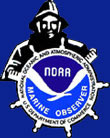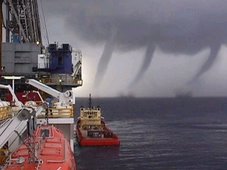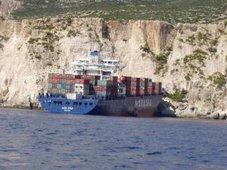 New weather project could help track tornadoes more closely
New weather project could help track tornadoes more closely By Ellis Goodwin, Daily Staff Writer
The 1996 movie "Twister" showed storm chasers travelling across Oklahoma and Kansas toting Dorothy, a mobile device that launches hundreds of flying sensors into a tornado.
In the film, Dorothy works by collecting data from the sensors, but in real life that would be nearly impossible, said Don Burgess, retired National Severe Storms Lab meteorologist.
Burgess said Dorothy is just a movie prop. It was based on a real piece of technology from the early '80s that did not fling hundreds of sensors into the air. Instead of Dorothy, it was called the Totable Tornado Observatory - TOTO for short.
TOTO weighs a few hundred pounds and holds basic atmospheric sensors that measure temperature, wind speed, pressure, dew point and other atmospheric characteristics, Burgess said. Burgess said the National Severe Storm Lab used TOTO for four or five years, but they did not have much success with it. It was big, bulky and difficult to put in the path of a tornado.
"There was just one TOTO; it was heavy and took a while to deploy," Burgess said. "We got close a number of times but had a problem getting a tornado to go right over it "
The technology in TOTO was high-tech for its time, but forecasters needed better technology to learn more about tornadoes, Burgess said.
In the mid '90s, a new design, VORTEX 1, incorporated new technologies developed after TOTO, NSSL Deputy Director Kevin Kelleher said.
Burgess said the VORTEX 1 machines that replaced TOTO are called Turtles. These devices are smaller and easier to deploy, and there are numerous units that can be placed in a grid.
Kelleher and Burgess described these devices as large, upside-down metal bowls that are loaded with atmospheric sensors. "You can set those out real quick so you don't have to worry as much about the safety factor," Burgess said.
Kelleher said forecasters learned a lot from VORTEX 1, but it there was still a lot to discover.
"VORTEX 1 was initially designed to find out what causes rotation," Kelleher said. "We wanted to forecast how [tornadoes] occur and how they dissipate, and what we learned is there is a lot we don't know."
New Technology
Large-scale tests like VORTEX 1 happen fairly rarely, NSSL Research Meteorologist Lou Wicker said. "VORTEX 1 made a significant difference," Wicker said. "But now we have a lot more technology to make real-time predictions, which can increase warning times."
The NSSL and National Oceanic and Atmospheric Administration are working with the National Science Foundation to develop VORTEX 2, Kelleher said.
VORTEX 2 is a bigger and better version of the original VORTEX project, he said. The NSSL will prepare this spring for the test, which will be conducted in the springs of 2009 and 2010, Kelleher said.
"It is basically VORTEX 1 on steroids," Wicker said.
VORTEX 2 was developed to give researchers a better understanding of tornadoes and increase the warning time for those in the path of tornadoes, Kelleher said. VORTEX 2 should help forecasters complete the picture of how and why tornadoes occur, he said.
"The goal is to use the best observations we have now and all of the information we gathered in VORTEX 1, and take that to make models," Kelleher said. "The end game is to help forecasters predict what is going on more accurately."
In VORTEX 2, the NSSL and partners will track the storm from all sides at three different levels and will use most of today's available forecasting technology.
Tracking a storm
The first level of observation includes Turtles, Stick-nets – another type of sensor – and Mobile Mesonets, vehicles with sensors attached to their roofs. This level of observation records basic atmospheric functions.
The second level of observation is conducted by trucks called Shared Mobile Atmospheric Research and Teaching Radars, known as SMART-Radars.
In 1997, OU, the NSSL and other partners developed these trucks, which are 34 feet long and have a 5 cm Doppler radar dish in the back, said Mike Biggerstaff, associate professor of meteorology and director of the SMART-Radar program. The 5 cm dish is less powerful than the larger stationary 10 cm Doppler radars, but its mobility allows it to move much closer to a storm and observe a clearer picture, he said.
The SMART-Radars are able to use radar signals to penetrate the storm, which bounce back and produce an image of what the storm looks like, Biggerstaff said.
"We can see the entire storm scale, the effect of the updrafts and the downdrafts on the development of circulation," he said.
On the third level of observation, behind the SMART-Radars, are the larger stationary 10 cm Doppler radar dishes. These radars provide a much farther-reaching radar sweep, Biggerstaff said. The more powerful beam provides a picture of the storm and areas surrounding it. Like the smaller radars, these take data and plug them into a computer algorithm, which creates a map of the storm, he said.
In VORTEX 2, the NSSL will also incorporate the new phased array radar, which was developed by the military. Phased array radar uses multiple beams and frequencies to reduce scanning time and can give forecasters minute by minute updates, Kelleher said.
Biggerstaff said there has never been a weather experiment as extensive as this one. And what makes VORTEX 2 so unique is the combination of all the technologies to create a data set that can be used to forecast future storms.
"I don't even think we have found all the ways that tornadoes form," Biggerstaff said. "We need to be able to observe all the scales of motion, and VORTEX 2 is designed to allow that to happen.”
WEATHER NOTES
The UK Chief Fire and Rescue Adviser’s review of the operational response by the Fire and Rescue Service to the widespread flooding in England during 2007 has been released. PDF at:
http://www.communities.gov.uk
Tornadoes in 2008

Here’s a look at where tornadoes have occurred in 2008 so far. Tornado season starts in the deep south and migrates north and northwest. Note the few number of tornadoes in the Plains States.
We have had 69 tornado fatalities in the U.S. (and it’s still winter!), well ahead of average. A total of 465 tornadoes have been reported. Usually we go until late May to get that many tornadoes.There have been 19 “killer tornadoes” in 9 states. 37 of the 69 fatalities were people inside mobile homes (which, unfortunately, tend to become more mobile in a tornado). Note the isolated tornadoes in California and Oregon (small spinups). There are two advantages to cool weather in late March and April…less severe weather and the blossoms don’t come out too soon. We should stay a little cooler than average through the rest of March.
Fortified Homes Capture Growing Interest In Wake Of Disasters
The insurance industry takes special note of the changes in weather patterns that are doling out
 spectacular new property losses. A spokesperson for the Institute for Business and Home Safety, (IBHS) a non-profit supported by the insurance industry, recently remarked:
spectacular new property losses. A spokesperson for the Institute for Business and Home Safety, (IBHS) a non-profit supported by the insurance industry, recently remarked: "Ours is not to decide why it's happening, we just know disasters are more prevalent."
While "fortified" homes can refer to structures designed in the tradition of Joel Skousen as a buffer against uncertain times and to enhance survival in times of civil unrest, the term is now being used to describe structures that can resist, or survive, natural disasters.
Last week one such home was dedicated in Louisiana by Louisiana System Built Homes. IBHS sets out requirements for a home to be designated as "fortified," and the process includes inspections by those trained in inspecting for this purpose. It might surprise some to know that this home is largely built in a factory setting and transferred to the building site where it is assembled. This particular company uses SIPs as the building blocks.
IBHS certification promises to reduce insurance costs for the building owner. Requirements are related to where the structure is being built so they will vary from place to place but in Louisiana some of the requirements are:
- Able to withstand wind speeds 20 mph higher than those established by the American Society of Civil Engineers;
- Able to withstand high pressure at doors and windows;
- Able to withstand water penetration, high winds and hail in the roof area.
In Seattle, where another of these homes was recently certified, requirements look like this:
- Concrete construction must exceed seismic code standards by 20 percent;
- Roof to wall to foundation connections have to be able to stand 130 mph winds;
- Light metal roofs that resist shaking momentum but still also resist wind, hail and fire;
- Two moisture barriers below the roof covering;
- Windows and doors with a high degree of wind and water resistance.
By visiting this IBHS page you can view a number of videos with tips for fortifying buildings.
IBHS is also taking on the tough question that people always ask after a community sustains major losses from a natural disaster that was always expected to happen: "Why did they let them build there?"
You've all heard that one asked after yet another flood wipes out a portion of a community where the same thing happened in recent memory. As you might expect, answering the question requires getting into the nits and grits of some very formidable topics not the least of which have to do with property values and feelings related to "home." IBHS is advocating more comprehensive incorporation of natural hazards when communities consider land-use.
Images from the 03/15/08 tornadoes in Floyd and Polk County.
MARITIME NOTES
Independent Assessment by Coast Guard on Marine Safety program
In November 2007, VADM James C. Card, Ret. completed an independent assessment and analysis of the Coast Guard’s Marine Safety program. Below is taken from the introduction and gives a brief over view of the document:
Recently, Congress and the industry have criticized the Coast Guard because they believe Coast Guard Marine Safety performance and service have deteriorated. Many point to the Coast Guard’s increased role in Maritime Security and its move to the Department of Homeland Security as primary reasons for the deterioration. Coast Guard Marine Safety professionals also have concerns about the Coast Guard’s lack of focus on Marine Safety as an important mission.
The results gathered in this report show that concerns and suggestions fall into six major categories. Listed by priority they are: Strategy; Leadership; People; Policy; Customer Focus; and Organization.
Here is the link to the rest of the document Coast Guard Marine Safety Analysis
RS


































































































![Validate my RSS feed [Valid RSS]](valid-rss.png)